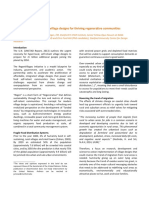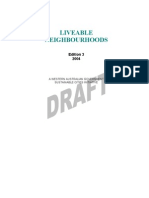Housing Assignment
Housing Assignment
Uploaded by
Aishwarya KambleCopyright:
Available Formats
Housing Assignment
Housing Assignment
Uploaded by
Aishwarya KambleCopyright
Available Formats
Share this document
Did you find this document useful?
Is this content inappropriate?
Copyright:
Available Formats
Housing Assignment
Housing Assignment
Uploaded by
Aishwarya KambleCopyright:
Available Formats
Subject - Housing MIS No.
111914005
Assignment No.2 Name - Aishwarya Santosh Kamble
Question : Explain the Concept of Neighbourhood in detail.
Answer :
• Introduction of Neighbourhood Concept by Famous Planners
The term neighbourhood is used to describe the sub-divisions of urban or rural
settlements. In simple terms , a neighbourhood is the vicinity in which people live.
Neighbourhoods are often social communities with considerable face-to-face interaction
among members. Many Planners and Architects described their idea of neighbourhood in
their work.
Neighbourhood idea of Clarence Stein and Henry Wright in plan for Radburn and
Neighbourhood Unit Idea of Clarence Perry were both published in 1929.
Lewis Mumford presented ‘neighbourhood’ as a ‘fact of nature’, which comes into
existence whenever a group of people share a place. Since the early ages of humanity, for
practical, economical, sociological and psychological reasons, people have tended to live close
together in sections of an area and form communities.
Arnold Whittick (1974) describes neighbourhood unit as an integrated, and
planned urban area related to the larger community of which it is a part, and consisting of
residential districts, a school or schools, shopping facilities, religious buildings, open spaces,
and perhaps a degree of service industry.
• Evolution and Conceptualisation of Neighbourhood
The ‘neighbourhood unit’ evolved in response to the degenerated environmental
and social conditions fostered because of industrial revolution in the early 1900s.
a) Clarence Perry’s Model :-
One of the earliest authors to attempt a definition of the ‘neighbourhood unit’ in
specific terms was Clarence Arthur Perry (1872-1944), a New York planner. While the origin of
the concept of the neighbourhood unit may be cited at an early date, it was the publication of
Clarence A. Perry’s memorandum entitled ‘The Neighbourhood Unit’ in the 1929 ‘Regional
Plan of New York and Its Environs’, which led to its promotion as a planning tool. Perry’s
monograph offered in concrete terms a diagrammatic model of the ideal layout for a
neighbourhood of a specified population size. This model provided specific guidelines for the
spatial distribution of residences, community services, streets and businesses.
Perry outlined six basic principles of good neighbourhood
design as follows :
1. Major arterials and through traffic routes
should not pass through residential neighbourhoods.
Instead these streets should provide boundaries of the
neighbourhood;
2. Interior street patterns should be
designed and constructed through use of cul-de-sacs,
curved layout and light duty surfacing to encourage a
quiet, safe and low volume traffic movement and
preservation of the residential atmosphere;
3. The population of the neighbourhood
should be that which is required to support its elementary
school;
4. The neighbourhood focal point should be the elementary school centrally located on
a common or green, along with other institutions that have service areas coincident
with the neighbourhood boundaries;
5. The radius of the neighbourhood should be a maximum of one quarter mile thus
precluding a walk of more than that distance for any elementary school child; and
6. Shopping districts should be sited at the edge of neighbourhoods preferably at major
street intersections.
b) Clarence Stein’s Model
Clarence Stein placed the elementary school at
the centre of the neighbourhood unit and within
¼ mile radius of all residents. A small shopping
centre for daily needs is located near the school.
Most residential streets are suggested as cul-de-
sac or ‘dead-end’ roads to eliminate through
traffic, and park space flows through the
neighbourhood in a manner reminiscent of the
Radburn Plan. He further expanded the definition
of neighbourhood centre by connecting the
neighbourhoods together to create towns. The
diagram shows the grouping of three
neighbourhood units served by a high school and
one or two major commercial centres, the radius
for walking distance to these facilities being one
mile.
• CONCLUSIONS
Neighbourhoods form the urban tissue of the city both physically and socially.
The concept of the neighbourhood is well established as a basic unit of planning the cities.
Further, it is a popular and accepted element of social and physical organization in the minds
of most people. Hence the neighbourhood has become the symbol and the means to
preserve the socio-cultural values of an earlier less harried way of life in our increasingly
complex and fast-moving urban centres. This also causes enhancement in the social-cultural
bonds that would result as a direct outcome of improvement in physical conditions of a
neighbourhood.
• Source
Google -
From extra reading for better understanding of the subject.
You might also like
- Transportation and Sustainable Campus Communities: Issues, Examples, SolutionsFrom EverandTransportation and Sustainable Campus Communities: Issues, Examples, SolutionsNo ratings yet
- Dockside Green: The Story of the Most Sustainable Development in the WorldFrom EverandDockside Green: The Story of the Most Sustainable Development in the WorldNo ratings yet
- Data Breach Response Plan 0Document7 pagesData Breach Response Plan 0Manuel MontesNo ratings yet
- Worksheet 5 - GALLARDO & SETIOTADocument2 pagesWorksheet 5 - GALLARDO & SETIOTAGallardo Joshua Jade75% (4)
- Neighbourhood PlanningDocument11 pagesNeighbourhood PlanningVidhu Krishna VsNo ratings yet
- Arch Design-IV (Brief of Urban Design)Document7 pagesArch Design-IV (Brief of Urban Design)Harshit GoyalNo ratings yet
- City ConceptsDocument46 pagesCity ConceptsFABIUS IHINDULIZANo ratings yet
- Aurovill E: National Institute of Construction Management & ResearchDocument21 pagesAurovill E: National Institute of Construction Management & ResearchKrishna BharathiNo ratings yet
- Smart MaterialsDocument27 pagesSmart Materialssri priyanka kathirvelNo ratings yet
- Site AnalysisDocument4 pagesSite AnalysisZarkima RanteNo ratings yet
- Draft: Project Name City Planning + DesignDocument15 pagesDraft: Project Name City Planning + Designaru jindalNo ratings yet
- ReGen Villages Integrated Village Design PDFDocument3 pagesReGen Villages Integrated Village Design PDFhariniNo ratings yet
- Green Surfaces: Known As "The Green Space of Qeshm Island"Document5 pagesGreen Surfaces: Known As "The Green Space of Qeshm Island"Sneha KalyanNo ratings yet
- Liveable Neighbour Hoods Ed3 - GWA Australia - 2004Document179 pagesLiveable Neighbour Hoods Ed3 - GWA Australia - 2004PublicHealthbyDesign100% (1)
- 14national Land Use PolicyDocument18 pages14national Land Use PolicyYash K. JasaniNo ratings yet
- Diamond Developers: - The Sustainable CityDocument34 pagesDiamond Developers: - The Sustainable CityGowtham SrinivaasNo ratings yet
- 01-Ar173-8th Sem-Landscape Design and Ecological Architecture-Unit 1-Part1Document24 pages01-Ar173-8th Sem-Landscape Design and Ecological Architecture-Unit 1-Part1VICKY KUMARNo ratings yet
- Notes 1Document20 pagesNotes 1Aayushi GoyalNo ratings yet
- Conceptual Problems: Sustainable Design (Also CalledDocument12 pagesConceptual Problems: Sustainable Design (Also CalledJaiDomeyegNo ratings yet
- Site AnalysisDocument6 pagesSite AnalysisChandan RawatNo ratings yet
- Architectural Glass: Production, Selection and Performance: Page 1 of 61 1Document61 pagesArchitectural Glass: Production, Selection and Performance: Page 1 of 61 1edbern20005873100% (1)
- Housing Planner WorksDocument7 pagesHousing Planner WorksKim LucenaNo ratings yet
- Influences On Architectural DesignDocument25 pagesInfluences On Architectural DesignJera MallariNo ratings yet
- Urban Conservation and Its Role in Urban Design: Assignment-4Document11 pagesUrban Conservation and Its Role in Urban Design: Assignment-4juveriaNo ratings yet
- Architectural Policy: Poetic ArchitectureDocument6 pagesArchitectural Policy: Poetic ArchitectureKonZabetas Architects-engineersNo ratings yet
- Module2 Urbanplanningtheories-1Document52 pagesModule2 Urbanplanningtheories-1Jhon Christopher AdaNo ratings yet
- Unit Iv-Issues of Urban SpaceDocument21 pagesUnit Iv-Issues of Urban SpaceKabi lanNo ratings yet
- Project 1: Tectonic Design Studio (30%) : SRD 263 Architecture 2A - 2009 Project 1 OutlineDocument2 pagesProject 1: Tectonic Design Studio (30%) : SRD 263 Architecture 2A - 2009 Project 1 OutlineSalama HhbNo ratings yet
- Unit-04: Day Lighting and Natural VentilationDocument40 pagesUnit-04: Day Lighting and Natural VentilationSuruthi ATKNo ratings yet
- Auro VilleDocument13 pagesAuro VilleAan Abraham ChackoNo ratings yet
- IntroDocument24 pagesIntroGayathriNo ratings yet
- Architecture: For Other Uses, See - Further InformationDocument7 pagesArchitecture: For Other Uses, See - Further InformationshervinkNo ratings yet
- Bit Mesra M.arch SyllabusDocument22 pagesBit Mesra M.arch SyllabusniteshNo ratings yet
- Role of Real Estate Developers in Affordable Housing and Climate ChangeDocument53 pagesRole of Real Estate Developers in Affordable Housing and Climate ChangeCHALLA MOUNICANo ratings yet
- Renewable and Sustainable Energy Reviews: A.R. Dehghani-Sanij, M. Soltani, K. RaahemifarDocument14 pagesRenewable and Sustainable Energy Reviews: A.R. Dehghani-Sanij, M. Soltani, K. RaahemifarNaynaNo ratings yet
- Townscape - Unit 3 PDFDocument27 pagesTownscape - Unit 3 PDFShalini Minna100% (1)
- Housing Standards and Codes: Submitted byDocument36 pagesHousing Standards and Codes: Submitted byAnas KhanNo ratings yet
- Sustainable Communities Lecture OneDocument34 pagesSustainable Communities Lecture OneM Hammad ManzoorNo ratings yet
- B.Arch Programme, IX Semester Theory of Urban Design ARCH503Document33 pagesB.Arch Programme, IX Semester Theory of Urban Design ARCH503Vanshika DograNo ratings yet
- Cost Effective ArchitectureDocument29 pagesCost Effective ArchitectureGOVINDNo ratings yet
- Group-3: Submitted To-Ar. Meenakshi Singh Ar. Shaan Choudhary Ar. Monika SarafDocument81 pagesGroup-3: Submitted To-Ar. Meenakshi Singh Ar. Shaan Choudhary Ar. Monika SarafPurvita ShahNo ratings yet
- Urban PoliciesDocument4 pagesUrban PoliciesToLe PhuongThaoNo ratings yet
- 9.climate ComponentsDocument8 pages9.climate ComponentsmariyaNo ratings yet
- Site Planning and LandscapingDocument24 pagesSite Planning and LandscapingSnigdha BurmanNo ratings yet
- Green BuildingDocument12 pagesGreen Buildingsingh kumarNo ratings yet
- Concept of Town Planning DevelopmentDocument53 pagesConcept of Town Planning DevelopmentChania BhatiaNo ratings yet
- Human Settlements N Town PlanningDocument2 pagesHuman Settlements N Town PlanningMahitha Raavi50% (2)
- Urban Design Theory - Short Notes No.16Document23 pagesUrban Design Theory - Short Notes No.16Reshma GeorgiNo ratings yet
- Sustainable Design and Green Buidling Toolkit For Local GovernmentsDocument92 pagesSustainable Design and Green Buidling Toolkit For Local GovernmentsCarlos Sánchez LópezNo ratings yet
- Shaping NeighbourhoodDocument28 pagesShaping NeighbourhoodechanNo ratings yet
- Architecture (Latin: ArchitecturaDocument5 pagesArchitecture (Latin: ArchitecturaJaisurya SharmaNo ratings yet
- Water Awareness Center: Guide: Ar. Paranjyoti .R. PatilDocument27 pagesWater Awareness Center: Guide: Ar. Paranjyoti .R. PatilvaibhavNo ratings yet
- Ecistics The Science of Human SettlementsDocument15 pagesEcistics The Science of Human SettlementsCyhn GieNo ratings yet
- Cooling Energy Performance and Thermal Characteristics of A Naturally Ventilated Slim Double-Skin WindowDocument12 pagesCooling Energy Performance and Thermal Characteristics of A Naturally Ventilated Slim Double-Skin WindowManasviNo ratings yet
- MUP Syllabus-80creditsDocument22 pagesMUP Syllabus-80creditsRitu AgrawalNo ratings yet
- Solar Passive TechniquesDocument13 pagesSolar Passive TechniquesAnkit Kashmiri GuptaNo ratings yet
- Early PlannersDocument3 pagesEarly PlannersTrisha TanudraNo ratings yet
- Philippine ClimateDocument6 pagesPhilippine ClimateN/ANo ratings yet
- Climate ResponsiveDocument6 pagesClimate ResponsiveManish Bokdia100% (1)
- Green BuildingDocument9 pagesGreen Buildingkv19852009No ratings yet
- Jadhavgadh: Urban Design - Case StudyDocument8 pagesJadhavgadh: Urban Design - Case StudyAishwarya KambleNo ratings yet
- Theories of MigrationDocument14 pagesTheories of MigrationAishwarya KambleNo ratings yet
- Jadhavgadh: Urban Design - Case StudyDocument8 pagesJadhavgadh: Urban Design - Case StudyAishwarya Kamble100% (1)
- Darling Quarter Case StudyDocument9 pagesDarling Quarter Case StudyAishwarya KambleNo ratings yet
- John Rawls Justice As Fairness (A Theory of Justice Focused On Distributive Justice)Document2 pagesJohn Rawls Justice As Fairness (A Theory of Justice Focused On Distributive Justice)Maria KorunovskaNo ratings yet
- A Study On The Impact of Online Games On Generation ZDocument11 pagesA Study On The Impact of Online Games On Generation Zjuhy vincentNo ratings yet
- Gate PassDocument1 pageGate PassRuby Lequigan SupatNo ratings yet
- Anvar PV Vs PK Basheer 18092014 SCs140825COM986651Document16 pagesAnvar PV Vs PK Basheer 18092014 SCs140825COM986651Shobhit ShuklaNo ratings yet
- Idoc - Pub - Avaya Vs Cisco Comparison PDFDocument29 pagesIdoc - Pub - Avaya Vs Cisco Comparison PDFBittu BhandariNo ratings yet
- LM PodDocument4 pagesLM PodHimansu BisoiNo ratings yet
- Chapter 4: The Marketing Environment: Marketing Does Not Take Place in A VacuumDocument22 pagesChapter 4: The Marketing Environment: Marketing Does Not Take Place in A VacuumJackMonNo ratings yet
- For Office Use Only: WWW - Manit.ac - inDocument6 pagesFor Office Use Only: WWW - Manit.ac - insai projectNo ratings yet
- Procurement & Supply Management: Attempt All Questions and Submit Exam Papers Timely On The Given Email AddressesDocument2 pagesProcurement & Supply Management: Attempt All Questions and Submit Exam Papers Timely On The Given Email AddressesMohsin AliNo ratings yet
- Are Federal Systems Better Than Unitary SystemsDocument33 pagesAre Federal Systems Better Than Unitary SystemsMuizuriNo ratings yet
- Labour Law1Document2 pagesLabour Law1Mustaq AhmedNo ratings yet
- Course Managment SystemDocument74 pagesCourse Managment SystemAmanuel KassaNo ratings yet
- Public Procurement Rules, 2004Document21 pagesPublic Procurement Rules, 2004sajidNo ratings yet
- MRP: Material Requirement Planning ERP: Enterprise Resource PlanningDocument61 pagesMRP: Material Requirement Planning ERP: Enterprise Resource PlanningNandajan KanjirampallthNo ratings yet
- Dagasdas Vs Grand PlacementDocument2 pagesDagasdas Vs Grand PlacementDaphnie CuasayNo ratings yet
- Valeo SVA - Special Vehicle ApplicationsDocument4 pagesValeo SVA - Special Vehicle ApplicationsAbishek AbhNo ratings yet
- PDFDocument2 pagesPDFEric Villanueva MornaolNo ratings yet
- Person-Centered Counseling Applied To Stan's CaseDocument2 pagesPerson-Centered Counseling Applied To Stan's CaseREMY JOY CABANNo ratings yet
- Passport Application Form and GuidelineDocument4 pagesPassport Application Form and Guidelinegurdee100% (1)
- Abensour Against The Sovereignty of Philosophy Over PoliticsDocument29 pagesAbensour Against The Sovereignty of Philosophy Over PoliticscamilaNo ratings yet
- Evidence Notes - Interpretation of DocumentsDocument8 pagesEvidence Notes - Interpretation of DocumentsRobehgene Atud-JavinarNo ratings yet
- Four Simple Steps To Write A Case Study A Guide For NGOsDocument3 pagesFour Simple Steps To Write A Case Study A Guide For NGOsNouman Ahmad100% (1)
- Fendy Yudha Ci 29 JanDocument3 pagesFendy Yudha Ci 29 JanEcommerce The ManoharaNo ratings yet
- INTRODUCTION To Vegetable FarmingDocument2 pagesINTRODUCTION To Vegetable Farmingjim schaultzNo ratings yet
- EASA Module 11Document8 pagesEASA Module 11xristophorosNo ratings yet
- Soccer Basic Rules of SoccerDocument1 pageSoccer Basic Rules of Soccerkevin araujoNo ratings yet
- Reading Coach Powerpoint Use For VideoDocument15 pagesReading Coach Powerpoint Use For Videoapi-446199315No ratings yet
- Mitcham Carl Que Es La Filosofia de La TecnologiaDocument13 pagesMitcham Carl Que Es La Filosofia de La TecnologiacesarNo ratings yet





























































































